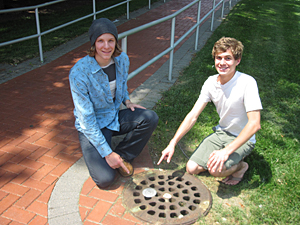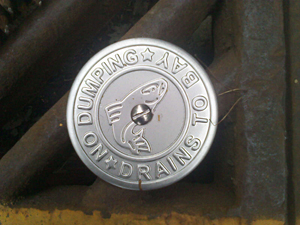ADVERTISEMENT
- Rozovsky wins prestigious NSF Early Career Award
- UD students meet alumni, experience 'closing bell' at NYSE
- Newark Police seek assistance in identifying suspects in robbery
- Rivlin says bipartisan budget action, stronger budget rules key to reversing debt
- Stink bugs shouldn't pose problem until late summer
- Gao to honor Placido Domingo in Washington performance
- Adopt-A-Highway project keeps Lewes road clean
- WVUD's Radiothon fundraiser runs April 1-10
- W.D. Snodgrass Symposium to honor Pulitzer winner
- New guide helps cancer patients manage symptoms
- UD in the News, March 25, 2011
- For the Record, March 25, 2011
- Public opinion expert discusses world views of U.S. in Global Agenda series
- Congressional delegation, dean laud Center for Community Research and Service program
- Center for Political Communication sets symposium on politics, entertainment
- Students work to raise funds, awareness of domestic violence
- Equestrian team wins regional championship in Western riding
- Markell, Harker stress importance of agriculture to Delaware's economy
- Carol A. Ammon MBA Case Competition winners announced
- Prof presents blood-clotting studies at Gordon Research Conference
- Sexual Assault Awareness Month events, programs announced
- Stay connected with Sea Grant, CEOE e-newsletter
- A message to UD regarding the tragedy in Japan
- More News >>
- March 31-May 14: REP stages Neil Simon's 'The Good Doctor'
- April 2: Newark plans annual 'wine and dine'
- April 5: Expert perspective on U.S. health care
- April 5: Comedian Ace Guillen to visit Scrounge
- April 6, May 4: School of Nursing sponsors research lecture series
- April 6-May 4: Confucius Institute presents Chinese Film Series on Wednesdays
- April 6: IPCC's Pachauri to discuss sustainable development in DENIN Dialogue Series
- April 7: 'WVUDstock' radiothon concert announced
- April 8: English Language Institute presents 'Arts in Translation'
- April 9: Green and Healthy Living Expo planned at The Bob
- April 9: Center for Political Communication to host Onion editor
- April 10: Alumni Easter Egg-stravaganza planned
- April 11: CDS session to focus on visual assistive technologies
- April 12: T.J. Stiles to speak at UDLA annual dinner
- April 15, 16: Annual UD push lawnmower tune-up scheduled
- April 15, 16: Master Players series presents iMusic 4, China Magpie
- April 15, 16: Delaware Symphony, UD chorus to perform Mahler work
- April 18: Former NFL Coach Bill Cowher featured in UD Speaks
- April 21-24: Sesame Street Live brings Elmo and friends to The Bob
- April 30: Save the date for Ag Day 2011 at UD
- April 30: Symposium to consider 'Frontiers at the Chemistry-Biology Interface'
- April 30-May 1: Relay for Life set at Delaware Field House
- May 4: Delaware Membrane Protein Symposium announced
- May 5: Northwestern University's Leon Keer to deliver Kerr lecture
- May 7: Women's volleyball team to host second annual Spring Fling
- Through May 3: SPPA announces speakers for 10th annual lecture series
- Through May 4: Global Agenda sees U.S. through others' eyes; World Bank president to speak
- Through May 4: 'Research on Race, Ethnicity, Culture' topic of series
- Through May 9: Black American Studies announces lecture series
- Through May 11: 'Challenges in Jewish Culture' lecture series announced
- Through May 11: Area Studies research featured in speaker series
- Through June 5: 'Andy Warhol: Behind the Camera' on view in Old College Gallery
- Through July 15: 'Bodyscapes' on view at Mechanical Hall Gallery
- More What's Happening >>
- UD calendar >>
- Middle States evaluation team on campus April 5
- Phipps named HR Liaison of the Quarter
- Senior wins iPad for participating in assessment study
- April 19: Procurement Services schedules information sessions
- UD Bookstore announces spring break hours
- HealthyU Wellness Program encourages employees to 'Step into Spring'
- April 8-29: Faculty roundtable series considers student engagement
- GRE is changing; learn more at April 15 info session
- April 30: UD Evening with Blue Rocks set for employees
- Morris Library to be open 24/7 during final exams
- More Campus FYI >>
8:45 a.m., Sept. 8, 2010----While taking a stroll through the University of Delaware, you may have come across one of hundreds -- 844, in fact -- of small metal medallions located on the numerous catch basins on campus and wondered what they are doing there.
Andrew Homsey, an associate policy scientist at the UD Institute for Public Administration's Water Resources Agency (WRA), said the medallions, which are purchased through the Department of Environmental Health and Safety's (EHS) stormwater program, serve as a way to track the locations of all of the catch basins in the area, as there were previously issues with accuracy as to where they were. The purchase of the medallions was made in order to comply with Environmental Protection Agency (EPA) requirements.
Knowing this information is important, Homsey said, so that UD officials can respond effectively to potential spills around campus and where possible contamination will travel once it enters the pipe system and how long it will take to get there.
Homsey said EHS staff originally selected the metal medallions for the reason that they lend themselves well to the University's high aesthetic standards and will prove to be more permanent than other industry alternatives. The WRA works with the EHS to coordinate the mapping, design the catch basin tagging and provide assistance with equipment.
Jennifer Pyle, environmental health and safety specialist at EHS, currently hosts and directs this project with support from the WRA and students. The EHS is a part of the Office of Campus and Public Safety.
In addition, UD is involved with the city of Newark in applying for a permit for stormwater discharge administered through the Environmental Protection Agency. To get a permit and become compliant with clean-water regulations, accurate stormwater infrastructure data are necessary, he said.
Homsey said it is important for people in the UD community to be aware of how interconnected the city's drainage and water systems are, as anything that goes on the ground or in the street is likely to end up in a local river.
“It is important to protect all of our waters, starting at the source,” he said. “Not to do so, is dangerous, and can lead to impaired health of the environment, ecosystems, and humans who rely on that water. The economic costs of cleanup and water treatment far outweigh the cost and trouble of keeping the 'bad stuff' out of the water in the first place.”
Sophomore Levi Sikes, an English major, and senior Shane Palkovitz, a human services and English double major, both in the UD Honors Program, are the two student workers who are using GPS data and GIS software to locate and keep track of where the medallions have been installed. Palkovitz said the duo is able to tag 30 to 40 storm drains with medallions on a good day.
“Many people over a long time have put a lot of effort into protecting our watersheds,” Palkovitz said. “We are fortunate to be involved.”
Sikes said working on the project has been an enjoyable and positive experience for him.
“I love having a job that is outside and takes me all over campus,” he said. “I have been surprised by how much I enjoy this job. You have to be able to find the joy in such seemingly ordinary things -- even marking storm drains.”
To learn more about stormwater, and related activities and opportunities across campus, visit the Watershed Action Team for Ecological Restoration (WATER) website. This site highlights stormwater issues, people and internship opportunities across several departments and units at the University.
Article by Jon Bleiweis




